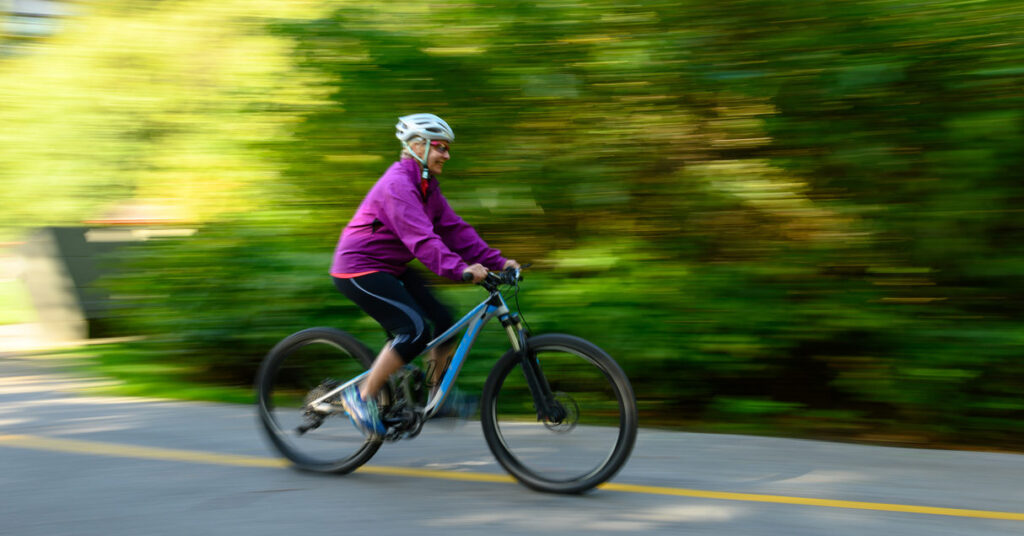5 TIPS FOR SAFE CYCLING

While biking outside is a great cardiovascular exercise and keeps you socially distanced, there is always a risk of injury. You cannot control drivers and the weather, but you can do a lot to make your ride safer and minimize the risks. Following these five tips will help you enjoy your ride and prevent serious injury.

1. Plan Your Route Ahead
The best way to make sure you have a safe, clear route is to plan ahead. Ideally, you should minimize busy roads, especially if there isn’t a bike lane. Consider the kind of ride you want to do (rolling hills, quiet country roads, etc.) and the starting/ending point. Google maps works well because you can often use the Satellite or even street view to see what the road looks like. It also has a feature that gives you directions from point to point via bicycle. In addition, there are several other route-planning sites and apps. My two favorites are Komoot (which can adjust the route based on your sport and fitness level) and RidewithGPS (which can download a file to your bike computer or phone).

2. Riding in the Street is (Usually) Safest
In most situations, it’s safest to ride on the street and not the sidewalk because you are most visible and obvious to motorists. Cars are just not looking for you on the sidewalk and are more likely to turn into a driveway without looking for you. You are also more likely to hit pedestrians, cracks, or litter on the sidewalk. That being said, I don’t like zipping across 2 lanes of traffic if I have to make a left turn. In this situation, I will ride up onto the sidewalk and use the crosswalk like a pedestrian, then continue on the shoulder when I get across the street.

3. Ride to the Side
Technically, you have the right to ride in the middle of the lane and block traffic as much as you want. In the eyes of the law, bikes are supposed to simply act like slow cars and follow all the rules of the road. In reality, however, you greatly increase your chance of creating road rage by holding up traffic! Stay as far to the right as possible, ideally across the white line. When there is a bike lane or a sufficiently wide shoulder, you should ride there. However, there will be roads with neither, and this is where you will need to use your judgment. If it’s safer to ride on the sidewalk, this may be your best option. The safest choice is to plan a route that does not include these kinds of roads (see tip #1).

4. Obey Traffic Laws
It costs you energy to stop for a stop sign and then start up again. But the stop sign is there for a reason, mostly to keep you safe! Don’t just blow through the intersection and risk getting hit. Also, you may pass cars on the right if there is a dedicated bike lane or shoulder, but if you’re just squeezing through a tight spot to get ahead, you are breaking the law.
You are also obligated to signal when you turn, which for bikes pretty much involves just pointing the way you intend to go. I have found that many motorists don’t understand the standard hand signals you may have learned in drivers’-ed class and will just get confused.
Remember that the police can and do give cyclists tickets for traffic violations!

5. Use Safety Gear
If you read my last blog, then you know that helmet use greatly reduces your risk of injury. Additionally, you should be as visible as possible to cars and pedestrians. Your bike is legally required to have reflectors at night, but actual lights work much better. I even have mine on blinking mode during the day for extra visibility. When riding at night, you should wear reflective clothing and ride defensively.

Let us help you prevent and recover from injury!
At Kintsugi Physical Therapy & Wellness, we want to promote your safety and wellness as much as possible, which starts with injury prevention. If you have pain, poor muscle function, imbalance, or stiffness, riding safely is that much harder. Luckily, physical therapy can help solve these problems!
If you are involved in a collision or crash on the bike, you may want to come in for an evaluation. We treat all kinds of sprains, strains, fractures, and head injuries. Even if your injury is years old, you might be surprised how much better your function can be with PT. Give us a call and schedule a visit!
